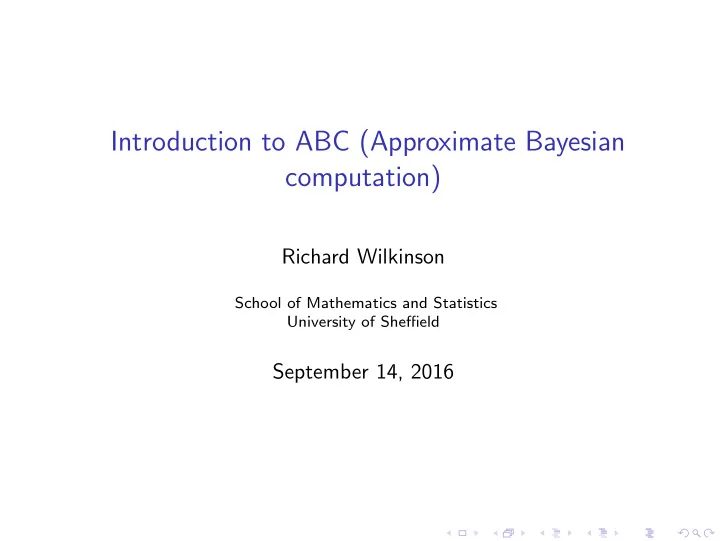

Introduction to ABC (Approximate Bayesian computation) Richard Wilkinson School of Mathematics and Statistics University of Sheffield September 14, 2016
Computer experiments Rohrlich (1991): Computer simulation is ‘a key milestone somewhat comparable to the milestone that started the empirical approach (Galileo) and the deterministic mathematical approach to dynamics (Newton and Laplace)’ Challenges for statistics: How do we make inferences about the world from a simulation of it?
Computer experiments Rohrlich (1991): Computer simulation is ‘a key milestone somewhat comparable to the milestone that started the empirical approach (Galileo) and the deterministic mathematical approach to dynamics (Newton and Laplace)’ Challenges for statistics: How do we make inferences about the world from a simulation of it? how do we relate simulators to reality? how do we estimate tunable parameters? how do we deal with computational constraints?
Calibration For most simulators we specify parameters θ and i.c.s and the simulator, f ( θ ), generates output X . The inverse-problem: observe data D , estimate parameter values θ which explain the data. The Bayesian approach is to find the posterior distribution π ( θ | D ) ∝ π ( θ ) π ( D | θ ) posterior ∝ prior × likelihood
Intractability π ( θ | D ) = π ( D | θ ) π ( θ ) π ( D ) usual intractability in Bayesian inference is not knowing π ( D ). a problem is doubly intractable if π ( D | θ ) = c θ p ( D | θ ) with c θ unknown (cf Murray, Ghahramani and MacKay 2006) a problem is completely intractable if π ( D | θ ) is unknown and can’t be evaluated (unknown is subjective). I.e., if the analytic distribution of the simulator, f ( θ ), run at θ is unknown. Completely intractable models are where we need to resort to ABC methods
Approximate Bayesian Computation (ABC) If the likelihood function is intractable, then ABC (approximate Bayesian computation) is one of the few approaches we can use to do inference.
Approximate Bayesian Computation (ABC) If the likelihood function is intractable, then ABC (approximate Bayesian computation) is one of the few approaches we can use to do inference. ABC algorithms are a collection of Monte Carlo methods used for calibrating simulators they do not require explicit knowledge of the likelihood function inference is done using simulation from the model (they are ‘likelihood-free’).
Approximate Bayesian computation (ABC) ABC methods are popular in biological disciplines, particularly genetics. They are Simple to implement Intuitive Embarrassingly parallelizable Can usually be applied ABC methods can be crude but they have an important role to play.
Approximate Bayesian computation (ABC) ABC methods are popular in biological disciplines, particularly genetics. They are Simple to implement Intuitive Embarrassingly parallelizable Can usually be applied ABC methods can be crude but they have an important role to play. First ABC paper candidates Beaumont et al. 2002 Tavar´ e et al. 1997 or Pritchard et al. 1999 Or Diggle and Gratton 1984 or Rubin 1984 . . .
Plan i. Basics ii. Efficient sampling algorithms iii. Links to other approaches iv. Regression adjustments/ post-hoc corrections v. Expensive simulators
Basics
‘Likelihood-Free’ Inference Rejection Algorithm Draw θ from prior π ( · ) Accept θ with probability π ( D | θ ) Accepted θ are independent draws from the posterior distribution, π ( θ | D ).
‘Likelihood-Free’ Inference Rejection Algorithm Draw θ from prior π ( · ) Accept θ with probability π ( D | θ ) Accepted θ are independent draws from the posterior distribution, π ( θ | D ). If the likelihood, π ( D | θ ), is unknown: ‘Mechanical’ Rejection Algorithm Draw θ from π ( · ) Simulate X ∼ f ( θ ) from the computer model Accept θ if D = X , i.e., if computer output equals observation � The acceptance rate is P ( D | θ ) π ( θ ) d θ = P ( D ).
Rejection ABC If P ( D ) is small (or D continuous), we will rarely accept any θ . Instead, there is an approximate version: Uniform Rejection Algorithm Draw θ from π ( θ ) Simulate X ∼ f ( θ ) Accept θ if ρ ( D , X ) ≤ ǫ
Rejection ABC If P ( D ) is small (or D continuous), we will rarely accept any θ . Instead, there is an approximate version: Uniform Rejection Algorithm Draw θ from π ( θ ) Simulate X ∼ f ( θ ) Accept θ if ρ ( D , X ) ≤ ǫ ǫ reflects the tension between computability and accuracy. As ǫ → ∞ , we get observations from the prior, π ( θ ). If ǫ = 0, we generate observations from π ( θ | D ).
Recommend
More recommend